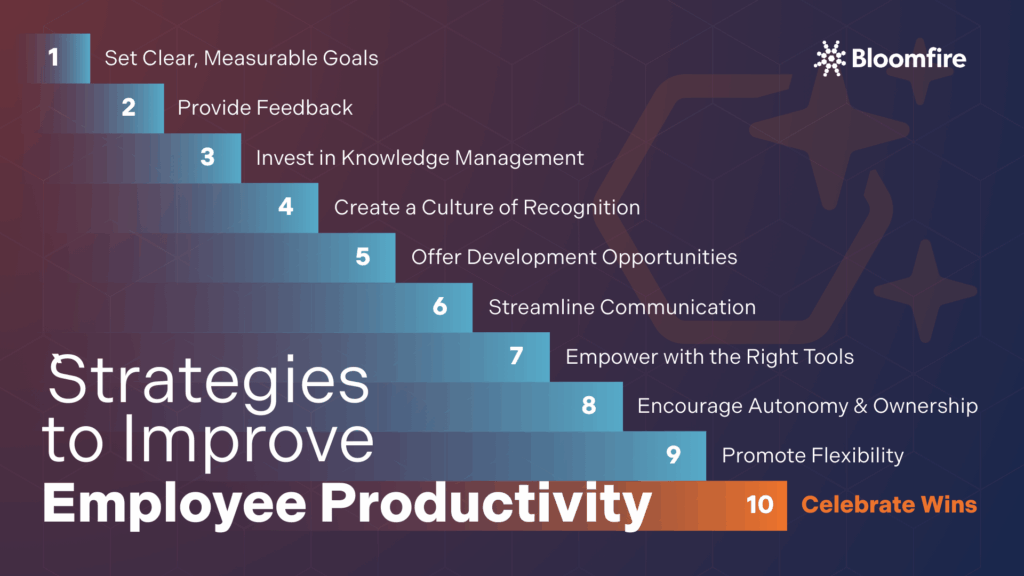How to Improve Employee Productivity: A Comprehensive Guide

Improving employee productivity is crucial for achieving organizational success. By understanding the elements that impact productivity, leaders can cultivate a workforce that is efficient and motivated. This guide explores the definition and importance of employee productivity, identifies common barriers to it, and offers practical strategies to enhance it.
We will also highlight the significance of equipping your team with the right tools. Leveraging these insights will empower you to cultivate a high-performance culture and steer your organization toward sustained success and growth.
What Is Employee Productivity?
Employee productivity measures how effectively individuals and teams complete their tasks in a given time frame. It reflects the output generated relative to the input of time, effort, and resources. Beyond a numbers game, productivity is about impact—achieving meaningful results without unnecessary burnout.
Key Metrics to Track:
- Output per hour: A classic productivity metric.
- Quality of work: Accuracy, completeness, and standards met.
- Deadline adherence: How reliably goals are met.
- Collaboration impact: Effectiveness in team-based work.
- Decision-making speed: How quickly employees move from insight to action.
Organizations may also track performance indicators, such as sales figures, customer satisfaction, or project completion rates, to gain a holistic view of productivity across roles. Understanding both individual productivity and team productivity enables organizations to tailor strategies that maximize employee productivity and identify ways to enhance it.
See Bloomfire in Action
Take a self-guided tour and explore how we help teams work smarter, not harder.
Take a Test Drive
Why Employee Productivity Matters
High productivity fuels growth and morale. Productive teams innovate faster, solve problems more efficiently, and drive measurable business outcomes. The Value of Enterprise Intelligence Report reveals that improving productivity through better knowledge access alone can unlock up to $27.1 million in annual gains per 100 employees.
Additional benefits include:
- Increased engagement and job satisfaction
- Faster onboarding and time-to-proficiency
- Lower turnover and training costs
- Better decision-making and agility
For organizations wondering how to increase employee productivity in the workplace, the key lies in building systems that remove friction and empower people with access to the information they need, when they need it.
What Affects Employee Productivity?
Optimizing employee productivity requires understanding several influencing factors:
1. Work Environment
Whether employees work from home, in an office, or in a hybrid setup, their physical environment plays a significant role in focus and energy. Natural light, ergonomic setups, and quiet, organized spaces support better concentration. For hybrid and remote teams, it’s also essential to establish clear norms regarding availability, virtual collaboration, and digital workspace consistency to minimize friction and maintain high productivity.
2. Employee Engagement and Motivation
Engaged employees feel a strong connection to their work and the organization’s goals, which in turn boosts productivity. Regular feedback, recognition, and professional development opportunities enhance morale and motivation. Open communication fosters a sense of value and empowerment.
3. Access to Knowledge
Employees spend an average of 8.5 hours per week searching for information without a robust KM system, highlighting the value of company-wide knowledge management.
4. Clarity of Expectations
Ambiguity leads to hesitation. Clear goals, aligned OKRs, and documented processes create momentum.
5. Work-Life Balance
Employees with a balanced personal and professional life experience tend to have lower stress levels, which in turn enhances their performance. Flexible work arrangements, breaks, and respect for personal time can help prevent burnout, leading to higher retention rates and a more harmonious workplace.
Addressing these factors can significantly improve productivity, benefiting both individual performance and overall organizational success. Exploring ways to enhance work performance and improve employee productivity are crucial steps in this process.
Common Causes of Low Productivity
Identifying obstacles to productivity is the first step toward creating a more efficient and engaged workforce. Below are some of the most common contributors to low employee productivity, and how to address them:
1. Inefficient Processes and Tools
Outdated systems, slow technology, or redundant workflows can significantly hinder performance. Streamlining operations and removing friction points boosts efficiency and reduces frustration.
2. Unclear Expectations
When roles, goals, or responsibilities are ambiguous, employees hesitate or duplicate efforts. Clear objectives and key results (OKRs), documented processes, and regular alignment sessions can eliminate this uncertainty.
3. Poor Communication
Misunderstandings and inconsistent feedback often result in wasted time and lost momentum. Structured communication channels and a culture of transparency help bridge these gaps.
4. Inadequate Training and Resources
Employees without access to the right tools or knowledge often feel unprepared, which leads to lower confidence and an increased likelihood of mistakes. Investing in ongoing training and support improves both performance and job satisfaction.
5. Lack of Feedback and Recognition
When employees don’t feel seen or appreciated, engagement and productivity suffer. Regular feedback and public acknowledgment go a long way in motivating your team.
Addressing these root causes helps build a more productive environment where employees are equipped to thrive. Whether you’re focused on how to improve employee productivity or seeking new methods to maximize employee productivity across teams, resolving these issues is foundational.
How to Increase Employee Productivity in the Workplace
Implementing effective strategies can significantly enhance productivity and workplace morale. Key approaches include:
- Setting Clear Goals and Expectations: Defined objectives provide a roadmap for success. Use SMART criteria to create clear, attainable goals. Regular check-ins ensure alignment and allow for strategy adjustments.
- Provide Feedback: Constructive, consistent feedback helps employees grow. Combine formal reviews with informal touchpoints to maintain fluid communication and guarantee performance alignment.
- Invest in KM: Ensure that employees can easily find and share information. A purpose-built knowledge management system reduces the time wasted searching for answers and enhances the speed of decision-making.
- Create a Culture of Recognition: Celebrate wins, big or small. Recognition—whether peer-to-peer or top-down—builds morale and reinforces positive behaviors.
- Offer Development Opportunities: Growth drives engagement. Encourage learning through stretch assignments, mentoring, or professional development stipends.
- Streamline Communication: Limit unnecessary meetings and adopt clear, asynchronous channels when possible. Set expectations around responsiveness to avoid overload.
- Empower Teams with the Right Tools: Provide teams with access to digital tools that support their daily workflows—such as project management platforms or automation tools — that accelerate task completion and minimize manual effort.
- Encourage Autonomy & Ownership: Trust employees to take initiative. When people feel ownership over outcomes, they’re more motivated to deliver results.
- Promote Flexibility: Whether working remotely, in a hybrid setting, or an office, provide teams with the flexibility to work in ways that align with their needs and energy levels. Flexibility supports work-life balance and reduces burnout.
- Celebrate Wins: End projects with appreciation. Recognizing team achievements publicly boosts morale and maintains momentum.

These strategies promote efficiency, satisfaction, and organizational success. Exploring ways to enhance employee productivity and improving work performance are integral to these strategies.
Equipping Employees with Productivity Tools
Improving productivity involves providing the right technology and software solutions to support effective work. These tools streamline workflows and empower employees to execute tasks efficiently. Intuitive platforms facilitating collaboration and knowledge sharing enable teams to work smarter.
If you’re looking for actionable ways to maximize employee productivity, equipping your workforce with intuitive, centralized platforms should be a top priority.
Proper training ensures the effective use of technology. Investing in training programs enhances proficiency, boosting confidence and productivity. Without training, advanced software can hinder rather than help. Ongoing training and support are crucial for adapting to new technologies.
Creating a supportive infrastructure fosters productivity. This includes technology and a culture promoting collaboration, communication, and continuous learning. Supported employees engage more with their work and contribute positively to the team. Collaborative platforms and knowledge sharing enhance productivity by facilitating the exchange of ideas and information.
With the right tools and environment, organizations unlock workforce potential, driving innovation and success. Understanding how to increase employee productivity and exploring ways to increase employee productivity are key components of building a productive infrastructure.
Activating Enterprise Intelligence
One Bloomfire customer, a global confectionery company, improved productivity across 2,000 users by reducing search time by 1.4 hours per week and duplicate effort by 2.4 hours, saving over $30 million annually
These results stemmed from:
- Consolidating fragmented knowledge sources
- Activating insights through AI-powered surfacing
- Empowering users with search, curation, and sharing tools
Frequently Asked Questions
What’s the fastest way to increase employee productivity in the workplace?
Start by addressing the most common friction points: unclear expectations, poor access to knowledge, and underutilized tools. Quick wins often result from enhancing internal search capabilities and eliminating redundant processes.
How can generative AI help improve employee productivity?
Generative AI tools can surface relevant insights in real time, reduce the time spent searching for information, and automate routine tasks, helping teams focus more on impactful work. By learning how to optimize your knowledge content, you can ensure these tools surface it accurately and effectively.
Is there a difference between improving and maximizing employee productivity?
Yes. Improving productivity focuses on removing immediate barriers, while maximizing employee productivity looks at long-term systems, tools, and cultural alignment to drive sustained performance.
Build for Sustainable Productivity
Improving employee productivity isn’t about squeezing more output out of them. It’s about removing friction, unlocking knowledge, and creating environments where people do their best work.
To go deeper, explore the benefits of Enterprise Intelligence and how it supports long-term productivity and innovation.
By addressing both cultural and operational factors, you can create a high-performance workplace that’s not only more productive but also more human.
Explore the Bloomfire Platform
Discover the tools that reduce search time and boost team productivity at scale.
Learn more
How to Improve Customer Service in Call Centers: 21 Ways to Enhance Contact Center Experience

Innovative Ways Companies Are Using Knowledge Management

How to Implement a Knowledge Check in 6 Steps

Estimate the Value of Your Knowledge Assets
Use this calculator to see how enterprise intelligence can impact your bottom line. Choose areas of focus, and see tailored calculations that will give you a tangible ROI.

Take a self guided Tour
See Bloomfire in action across several potential configurations. Imagine the potential of your team when they stop searching and start finding critical knowledge.